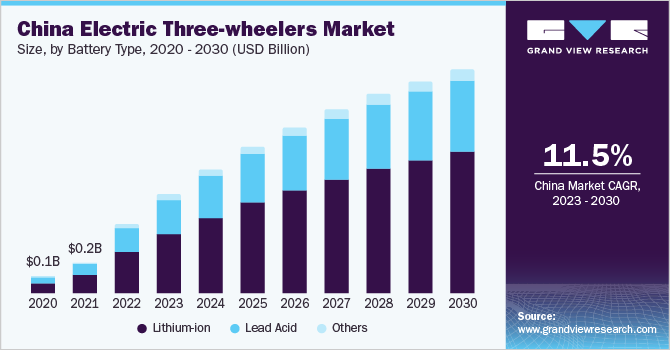The Asia Pacific electric three-wheelers market was valued at $1.05 billion in 2022, and is projected to reach $3.39 billion by 2030, growing at a Compound Annual Growth Rate (CAGR) of 12.3% from 2023 to 2030. The market's expansion is fueled by the growing adoption of electric three-wheelers in rural areas and in tier 2 and 3 cities, their role in providing affordable last-mile connectivity, and their low operational costs. The use of electric three-wheeler fleets by e-commerce and food delivery companies is also a significant driver. Furthermore, advancements in battery technology, the rise of battery-as-a-service business models, and the integration of connected vehicle technology are expected to create new opportunities for market growth.

Governments across the region are supporting this trend with incentive programs. These initiatives, which include purchase and manufacturing subsidies, pilot projects, and public-private partnerships, aim to speed up the deployment of electric three-wheelers. A prime example is India's Faster Adoption and Manufacturing of Electric Vehicles (FAME) scheme. Under FAME II, qualifying end-users are eligible for an upfront reduction in the vehicle's price.
Key Market Insights:
- By Battery Type: The lithium-ion (Li-ion) segment dominated the market in 2022, holding a market revenue share of over 60%. The demand for Li-ion batteries is driven by their longer life, improved energy density, compact size, faster charging, and reduced maintenance needs.
- By Power: The 1000 W to 1500 W segment was the largest in 2022, with a revenue share of over 59%. This is attributed to the increasing demand for electric three-wheelers with higher power ranges.
- By End-use: The passenger carrier segment held the largest market share in 2022, with over 55% of the total revenue. This segment's growth is due to the rising use of three-wheelers as a popular mode of public transportation for daily commutes and last-mile travel.
Order a free sample PDF of the Asia Pacific Electric Three-wheelers Market Intelligence Study, published by Grand View Research.
Market Size & Forecast
- 2022 Market Size: USD 1.05 Billion
- 2030 Projected Market Size: USD 3.39 Billion
- CAGR (2023-2030): 12.3%
Key Companies & Market Share Insights
The Asia Pacific electric three-wheelers market is consolidated, with a small number of key players holding the majority of the market share. These manufacturers often source components like battery power trains and thermal cooling systems from other companies or produce them in-house. They also make significant investments in research and development for battery and motor technology. To maintain their position, companies are engaging in strategic initiatives such as partnerships, new product launches, and mergers & acquisitions.
For instance, in June 2023, Omega Seiki Mobility (OSM) a company under the Anglian Omega Group, launched the OSM Stream City, an electric passenger three-wheeler. This vehicle features an 8.5 kWh lithium-ion battery and a manual boost gearbox. To enhance its offerings, the company also partnered with SUN Mobility to introduce battery-swapping technology for the vehicle. This collaboration aims to address concerns about charging time and range anxiety, making the electric three-wheeler a more attractive option for consumers.
Key Players
- Atul Auto Limited
- Hero Electric.
- Jiangsu Kingbon Vehicle Co., Ltd.
- Kinetic Engineering Limited
- Lohia Auto Industries (Zuperia Auto Private Limited.)
- Mahindra & Mahindra Limited
- Piaggio & C. SpA
- Saera Electric Auto Pvt. Ltd.
- Terra Motors Corporation
- Xianghe Qiansheng Electric Tricycle Factory
Explore Horizon Databook – The world's most expansive market intelligence platform developed by Grand View Research.
Conclusion
The Asia Pacific electric three-wheelers market is undergoing rapid transformation, driven by increased adoption in urban and rural mobility sectors. Factors such as affordability, low operating costs, and the surge in e-commerce logistics are fueling demand. Government incentives and evolving technologies, like battery-swapping and connected features, are further accelerating market penetration. The dominance of lithium-ion batteries and passenger carriers highlights shifting consumer preferences toward efficiency and reliability. Strategic moves by key players through innovation and partnerships are strengthening market competitiveness. Overall, the region is poised for robust growth as electric mobility continues to gain momentum.





